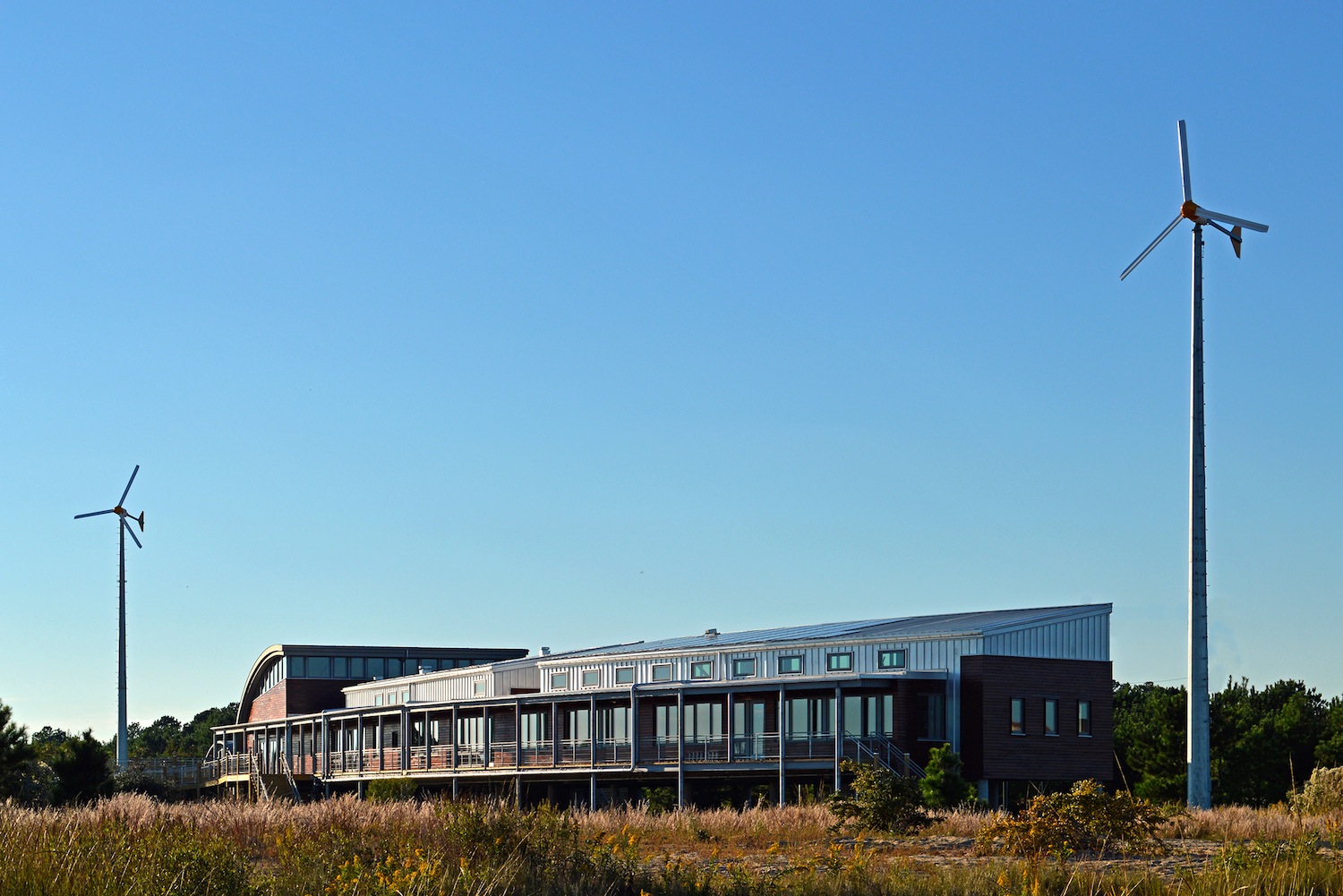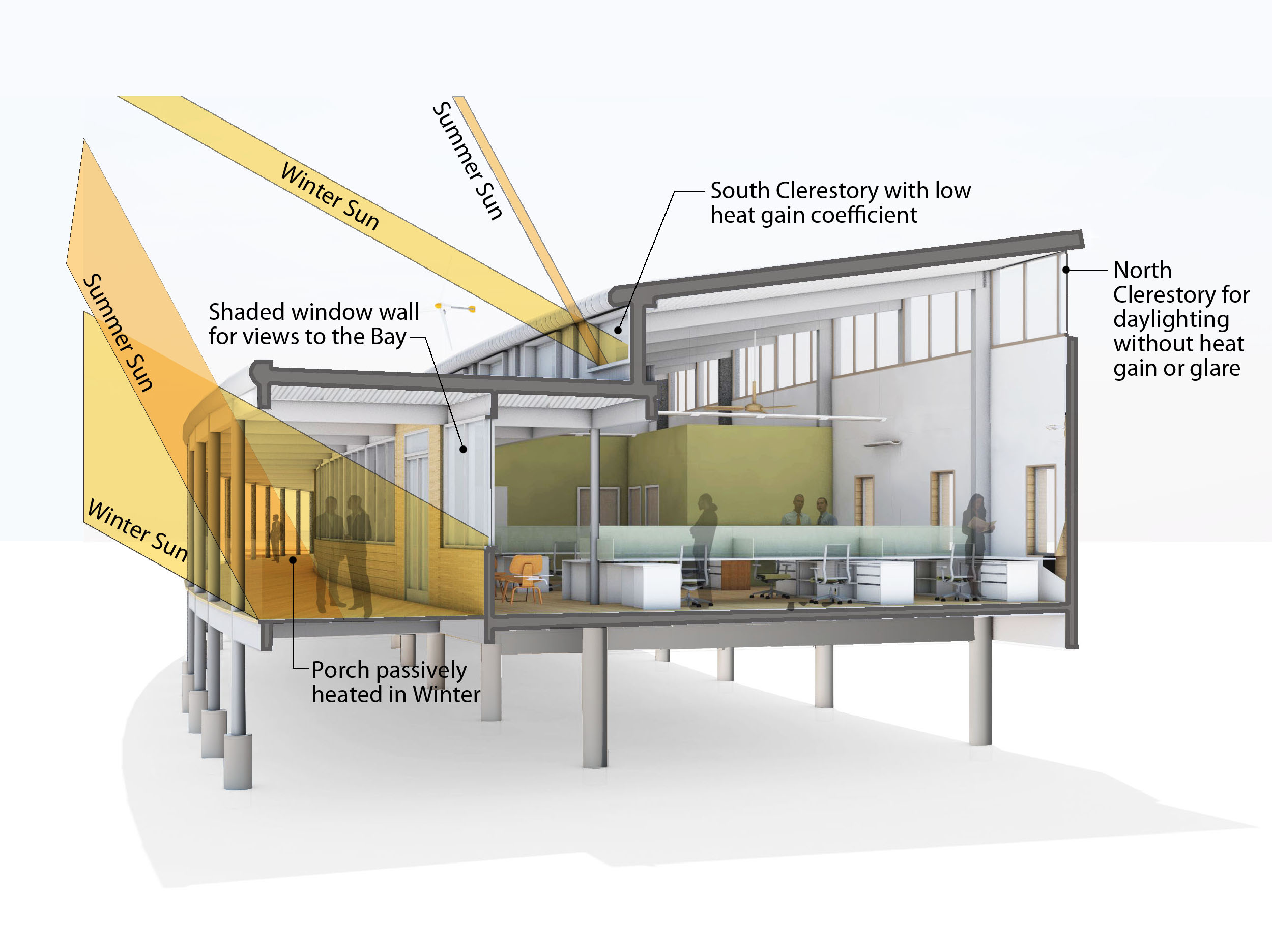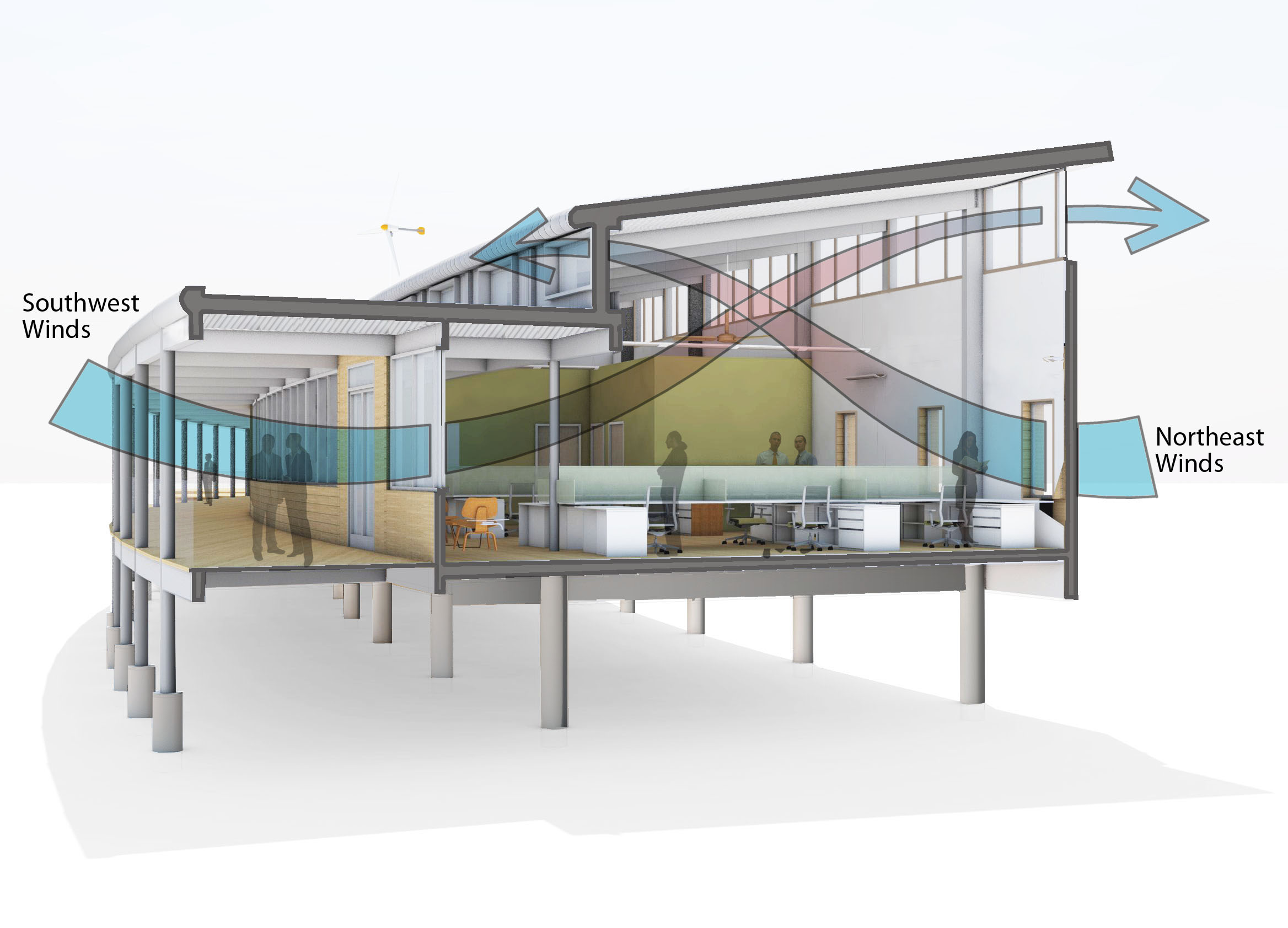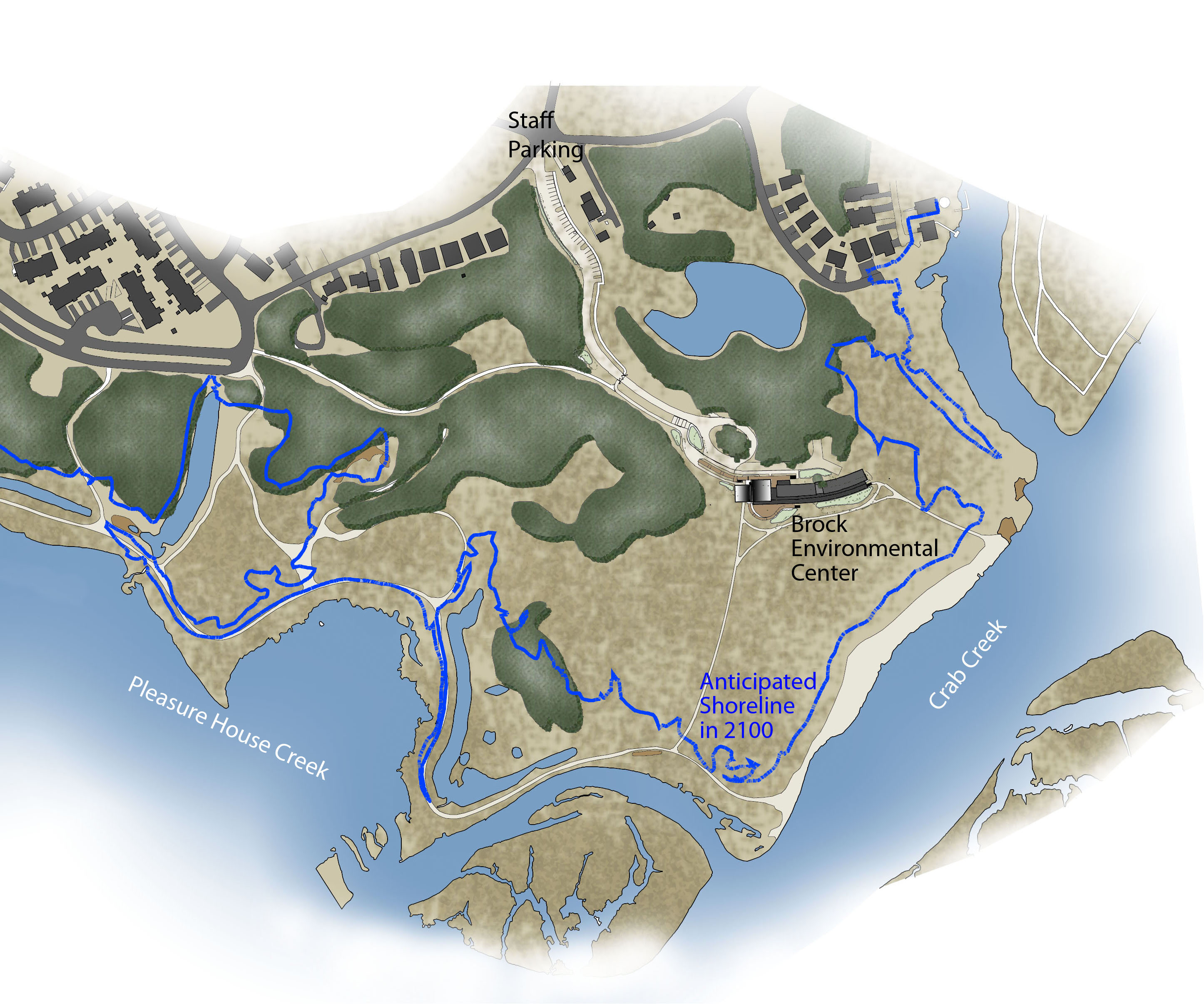The Chesapeake Bay Foundation’s (CBF) Brock Environmental Center reached construction completion today in Virginia Beach, Va. Designed by SmithGroupJJR and constructed by Hourigan Construction, the Center is an international model for energy and water efficiency and climate change resiliency.
The 10,000-sf, one-story building will serve as the hub for CBF’s Hampton Road office and support its Chesapeake Bay education, outreach, advocacy and restoration initiatives. In addition to offices for CBF and partner groups, the Center provides meeting rooms and exhibit display areas, and an 80-seat conference room designed to express CBF’s mission to defend one of the nation’s most valuable and threatened natural resources—the Chesapeake Bay.
Every aspect of the Center—location, materials, utilities, operation and use—meets the strictest environmental standards. “With the Brock Environmental Center, CBF is raising the bar for sustainability,” said Greg Mella, FAIA, LEED AP, SmithGroupJJR project manager and design architect.
“The Brock Center is a model for environmental awareness in our industry,” commented Mark Hourigan, president of Hourigan Construction.
The Center is targeting LEED Platinum designation and also strives to meet the strict standards of the Living Building Challenge (LBC), a green building certification program promulgated by the International Living Future Institute that defines the most advanced measure of sustainability in the built environment possible today. LBC standards require the facility to have “net zero” impact on the environment. The Brock Environmental Center would become the first building in Virginia to earn LBC certification; to-date, only five projects in the world have achieved Full Certification through the Living Building Challenge.
Designed for Resiliency on a Preserved Site
Completion of the Center concludes a successful community effort to save Virginia Beach’s 118-acre Pleasure House Point tract from development. As recently as 2008, developers intended to build more than 1,100 new high-rise condos and townhouses on the property. The collapse of the housing market in 2009, however, led to bank foreclosure of the property.
A community partnership with CBF, the City of Virginia Beach and the Trust for Public Land purchased the land from the bank in 2012, preserving it for open space and environmental education. The new Center, the only major structure on the entire 118 acres, takes up only one-half acre of CBF’s 10-acre parcel. Preserving the local ecology was paramount upon development of the site, which includes a boat pier with floating dock and an open-air education pavilion.
The project is situated on a coastal site to facilitate the client’s outdoor education program. The design anticipated the onset of sea-level rise and hurricanes: the building is set back 200 feet from the shore and sits on pylons 14 feet above sea level. Even the building’s structural steel system was designed to be capable of resisting 120-mph hurricane force winds.
“We had the opportunity to push the envelope on innovative and creative methods,” said Chris Brandt, executive vice president of Hourigan Construction. “There were so many certification levels that needed to be met that it was a job in itself to keep track of them all.”
Targeting Net-Zero Water, Energy and Waste
SmithGroupJJR designed the building to use very little energy by incorporating a series of aggressive, energy-saving features such as natural ventilation, natural daylighting and sunshading, highly efficient geo-thermal heating and cooling, and super insulation.
The Center is on track to be the first commercial-scale building in the continental U.S. to earn net-zero water status. A rainwater collection system will store rainwater in tanks under the building and then filter it for hand-washing and drinking through a state-of-the-art water filtration system licensed by the State of Virginia’s Office of Drinking Water. The Center features waterless, composting toilets, and all grey water (wastewater generated from sinks and showers) will be channeled through a wetland constructed of native plants where natural processes will clean and return it to the underground aquifer.
Net-zero energy status will be realized as the building generates its own electricity via solar and wind-powered renewable energy. The Center’s array of 38.8 kW rooftop photovoltaic panels will produce 60 percent of the building’s energy needs by converting the sun’s energy to electricity. Two small, 10-kilowatt wind turbines, 80’ tall, will contribute the remaining 40 percent of the building’s energy needs. Using only as much energy as it generates over the course of a year will enable the Center to earn net-zero energy certification. Surplus energy will be returned to the power grid.
Materials: Natural and Salvaged, “Red List” Chemicals Avoided
For the Center, construction materials were selected for their natural and simple properties. Preference was given to materials that are bio-based instead of those heavily processed, complex, synthetic and chemical-based. In specifying building materials, the design and construction team took special care to not use any materials on the International Living Future Institute’s “Red List,” which identifies chemicals and materials considered harmful to humans and the environment.
As a LBC requirement, recycled, salvaged and reclaimed materials were used extensively throughout the project. Examples include cypress siding from reclaimed sinker logs, wood flooring made from old fence posts and barn siding, interior wood trim from salvaged high school bleachers, and mirrors and toilet accessories from a local hospital demolition. The Rainwater Cistern and reception desk millwork were constructed from salvaged pickle barrels, and cabinet hardware consists of used champagne corks.
Hourigan Construction used cutting-edge building techniques in constructing the Center in order to minimize environmental impacts. In addition to using toxin-free building materials, sustainable measures used during construction included solar-powered tools and paperless construction documents. Normal construction equipment noise was reduced by the use of filters and baffles on the exhaust systems of all operating equipment, and slings or, in effect, construction equipment diapers were used so no equipment discharge would be deposited on the building site.
Even Hourigan’s on-site construction offices used less energy and water than normal systems. Instead of piping in treated water from the public grid, a deep fresh water well was installed to utilize existing water for construction use.
CBF: Continuing to Push the Boundaries of Sustainability
The Chesapeake Bay Foundation will occupy the building by the end of 2014. Prior, building occupants will be trained in the day-to-day operations and measurements of the renewable technologies. A 12-month measurement period is planned to commence in early 2015 and continue until early 2016. LBC certification is targeted for mid-2016.
The ultra-green Brock Environmental Center is the latest CBF initiative to push the boundaries of sustainability. The Foundation started with the 2000 completion of its Annapolis, Maryland headquarters building, the Philip Merrill Environmental Center, also designed by SmithGroupJJR. In 2001, the Merrill Center became the world’s first LEED Platinum building and was soon-after recognized as an international model of sustainability.
“What LEED Platinum was when we were designing the Philip Merrill Environmental Center, the Living Building Challenge is now,” said SmithGroupJJR’s Mella, who is based at the firm’s Washington, DC office. “Back then, we were designing to do less harm to the environment. Now, we’ve designed a building that could actually improve the environment,” he added.
The Brock Environmental Center is named in honor of Virginia Beach philanthropists Joan and Macon Brock in recognition of their $3.5 million donation toward the $21 million capital campaign to build, operate and endow a new Hampton Roads environmental center.
Joining SmithGroupJJR (architect and MEP engineer) and Hourigan Construction (general contractor) were WPL Site Design, Virginia Beach, civil engineer and landscape architect; and A+F Engineers, Washington, DC, for structural engineering. Skanska, New York, NY, served as the owner’s representative.
SmithGroupJJR (www.smithgroupjjr.com) is a recognized, integrated design firm with 800 employees in 10 offices. With more than 100 LEED certified projects and 343 LEED professionals, SmithGroupJJR is a national leader in sustainable design.
Hourigan Construction (www.houriganconstruction.com) is a full-service construction management company with operations throughout the Southeast U.S. The firm has constructed multiple projects in the Hampton Roads region and across Virginia.
Related Stories
Green | Feb 15, 2024
FEMA issues guidance on funding for net zero buildings
The Federal Emergency Management Agency (FEMA) recently unveiled new guidance on additional assistance funding for net zero buildings. The funding is available for implementing net-zero energy projects with a tie to disaster recovery or mitigation.
Hospital Design Trends | Feb 14, 2024
Plans for a massive research hospital in Dallas anticipates need for child healthcare
Children’s Health and the UT Southwestern Medical Center have unveiled their plans for a new $5 billion pediatric health campus and research hospital on more than 33 acres within Dallas’ Southwestern Medical District.
Architects | Feb 13, 2024
Pierluca Maffey joins Carrier Johnson + Culture as new Firmwide Head of Design
Carrier Johnson + Culture (CJ+C) has hired Pierluca “Luca” Maffey, International Assoc. AIA, as the firm's new Firmwide Head of Design and Design Principal.
K-12 Schools | Feb 13, 2024
K-12 school design trends for 2024: health, wellness, net zero energy
K-12 school sector experts are seeing “healthiness” for schools expand beyond air quality or the ease of cleaning interior surfaces. In this post-Covid era, “healthy” and “wellness” are intersecting expectations that, for many school districts, encompass the physical and mental wellbeing of students and teachers, greater access to outdoor spaces for play and learning, and the school’s connection to its community as a hub and resource.
Office Buildings | Feb 13, 2024
Creating thoughtful tech workplace design
It’s important for office design to be inspiring, but there are some practical principles that can be incorporated into the design of real-world tech workplaces to ensure they convey an exciting, sophisticated allure that accommodates progressive thinking and inventiveness.
Airports | Feb 13, 2024
New airport terminal by KPF aims to slash curb-to-gate walking time for passengers
The new Terminal A at Zayed International Airport in the United Arab Emirates features an efficient X-shape design with an average curb-to-gate walking time of just 12 minutes. The airport terminal was designed by Kohn Pedersen Fox (KPF), with Arup and Naco as engineering leads.
Higher Education | Feb 9, 2024
Disability and architecture: ADA and universal design at college campuses
To help people with disabilities feel part of the campus community, higher education institutions and architects must strive to create settings that not only adhere to but also exceed ADA guidelines.
Codes | Feb 9, 2024
Illinois releases stretch energy code for building construction
Illinois is the latest jurisdiction to release a stretch energy code that provides standards for communities to mandate more efficient building construction. St. Louis, Mo., and a few states, including California, Colorado, and Massachusetts, currently have stretch codes in place.
Giants 400 | Feb 8, 2024
Top 10 Telecommunications Building Architecture Firms for 2023
Arcadis North America, CSArch, Interior Architects, and TETER top BD+C's ranking of the nation's largest telecommunications building architecture and architecture/engineering (AE) firms for 2023, as reported in Building Design+Construction's 2023 Giants 400 Report.
Giants 400 | Feb 8, 2024
Top 50 Public Library Architecture Firms for 2023
Quinn Evans, McMillan Pazdan Smith, PGAL, Skidmore, Owings & Merrill, and Gensler top BD+C's ranking of the nation's largest public library architecture and architecture/engineering (AE) firms for 2023, as reported in Building Design+Construction's 2023 Giants 400 Report.




















